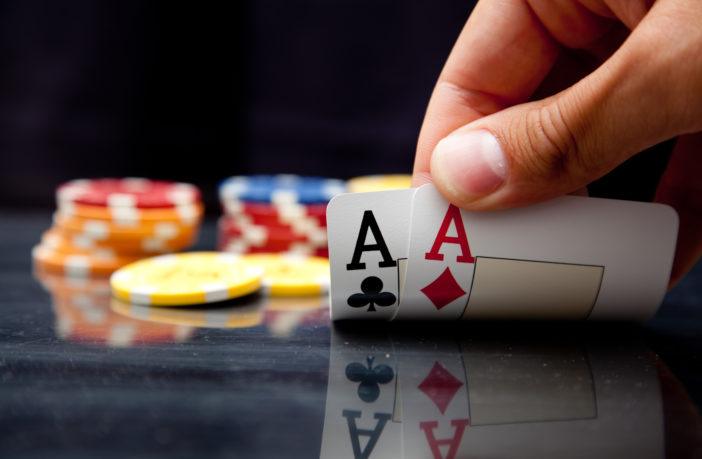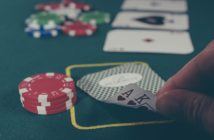Have you ever dreamed about playing poker with the big boys? If so, you might need a little more than a poker for dummies guide to the game.
The world of poker has international stars like Daniel Negreanu and Joe Hachem. These guys have won (and lost) millions in their careers.
But if you want to play poker like a champion, you’ve got to start with the basics. Like anything else, poker requires practice and skill.
Here’s a comprehensive discussion of basic poker rules. Many of these rules apply both online and in person.
Continue reading to learn the difference between a flop and the river, and how they apply to a real game.
Your Invitation to the Best Online Pokies in Australia
Like a punt on the slot machines?
Our top rated slots for October 2019 are the smash-hit online pokie sites: Ruby Fortune and Jackpot City Casino.
These sites include some impressive matched bonuses – up to $750 and $1600 respectively! With the potential for some seriously big wins, here’s your chance to get a piece of the action:
Poker Rules: Texas Hold’em
There are hundreds of poker variations. In this article, we’ll focus on a community game called Texas Hold’em. Often, Texas Hold’em is played “no limit”, meaning no bets are off limits.
It is also the most widely played poker variation, both online and in the professional tournament circuit.
The object of Texas Hold’em is to have the best five card hand on the table. Or to pretend like you do and out-bluff the other players.
It takes more skill than it does luck to win at Texas Hold’em.
Your Hand
You have two cards, called the hole cards, that only you can see. They will be part of your five card hand.
Card Rankings
What exactly is the best five card hand? Here are the possibilities, ranked in order of best to worst.
- Royal flush – A,K,Q,J,10 all in the same suit.
- Straight flush – Five cards in a sequence, all the same suit.
- Example: 8,7,6,5,4 of diamonds
- Four of a kind – Four cards of the same value.
- Full house – Three of a kind and a pair.
- Example: 10,10,10,8,8
- Flush – Five cards of the same suit but not in sequence.
- Example: 2,4,5,8,9 of hearts
- Straight – Five cards in sequence but not the same suit.
- Example: 9,10,J,Q,K all different suits
- Three of a kind – Three cards of the same value.
- Two pair – Two pairs of the same value.
- Example: J,J,Q,Q
- A pair – Two cards of the same value.
- High card – When you have none of the previous hands, your highest card plays.
Keep Your Hole Cards Secret
Ever heard the term “keep’em close to your vest”? That’s what a good poker player does, he keeps his hole cards close to his vest or hidden.
Your best bet is to keep them on the table. Lift them slightly at the edge so you can see the value and suit. Then put them right back down.
Look at them as seldom as possible.
The Players
Let’s take a look at some of the roles of the players at the table. Your responsibility will shift between these positions with each new hand.
Dealer
If you’re playing in a casino, the dealer remains the same and does not play. But, if you’re playing at home, or in some online forums, the players themselves must rotate duties as the dealer.
The first dealer, chosen at random, starts the game by dealing the hole cards. The dealer always deals to their left and deals two cards to each player, including himself.
Dealer position moves to the player directly to the left of the dealer for each game following the first.
You can choose a chip to stand as the “dealer chip” and move that around the table to keep track of who is in dealer position.
Blinds
A blind is a forced bet that changes position after each game. The purpose of this bet is to give the field a pot to play for. Since the position changes every game, there is no disadvantage to any player for having to take on the blind position.
There are two types of blinds in Texas Hold’em: the small blind and the big blind. The dollar amount of the big blind is a predetermined minimum bet. The small blind is half of the big blind.
The small blind is the player sitting directly to the left of the dealer. The big blind sits directly to the left of the small blind.
For every game, the pot starts at exactly 1.5 times the minimum bet. Of course, it doesn’t stay that low for long. Players usually bet and raise the stakes almost immediately.
How to Read the Other Players
They don’t call it a “poker face” for nothing. Reading your fellow players can give you a big advantage.
That’s why many professional poker players wear sunglasses and hats. They like to cover as much of their face as they can to prevent other players from reading them.
Poker tells are behavioral clues that might give you an idea about the strength of a player’s hand. Check out common poker tells and make sure you’re on the lookout for them.
Betting
After the dealer has dealt each player two hole cards, the first round of betting begins. It starts with the small blind and big blind putting in their chips.
The next player is the player immediately to the left of the big blind. For that player to continue playing, they must either call the big blind bet or raise it.
Call means to match the bet of another player. Raise means to increase the bet of another player.
If a player opts to raise the bet, then the rest of the players must call the new, higher bet to continue playing.
They do have a third option. They can fold, meaning they place their cards face down and push them toward the center of the table, out of play.
A player might fold on the first round if their hole cards are weak.
Betting continues in this way, circling the table clockwise until every player has either called the highest bet or folded.
The Flop
After the first round of betting, it’s time to see some more cards.
The dealer discards, or burns, the first card on the deck. Burning a card helps ensure that nobody has seen the card by accident.
After the burn card, the dealer lays the flop. The flop is three cards, all laid face up in the center of the table.
These are the first three community cards.
You now need to see how your hole cards look with the flop cards to determine how to bet after the flop.
A round of betting takes place after the flop. There are no longer any blinds, those only happen in the pre-flop round.
Post-flop, players can either check or raise. To check means that you opt not to bet. You signal a check by either saying, “Check” clearly or by tapping the table with your finger so that all players can see.
If all players check, the game moves on to the next round. But, if a player bets, then every player must either call the bet or fold their hand. You can always raise it as well when your turn rolls around.
At this point in the game, you’ve got a good idea of how your hand will stack up since you have five cards to work with.
The Turn and the River
Post-flop play is where the game heats up. Now is the time to pay special attention to player behavior.
Player tells can often give away the strength or weakness of their hand.
You must also be aware of your own poker behaviors.
Avoid excited gestures or defeated slumps. Don’t drink too much to keep your head in the game. Even throw out some fake tells of your own to confuse other players.
After the post-flop bet, the dealer burns a card and lays the turn. This is a single card, also laid face up next to the flop cards.
Then another round of betting.
Next, the dealer burns another card and lays the final community card, called the river.
Once the river is laid, the last round of betting begins. This is often the most exciting round.
A player can go all in by betting all their remaining chips. They can also put another player all in by betting the same amount of chips that another player has in their hand.
Once all the bets are placed and everyone is square, it’s time to see who won.
And the Winner Is…
You win the game when you make it through the last round of betting without folding and you have the best, five-card hand.
As noted before, you can use any of the seven cards in play to create the best hand.
Poker Rules: All In
There are hundreds of country songs written about playing poker. Why? Because poker is straight up fun. Ask Kenny Rogers.
Learning poker rules is essential to playing the game the way it should be: with skill and respect. Start small, do your research, practice as much as you can, and soon you could be playing poker with the champions.
Check out our local guide to playing poker in Australia.







